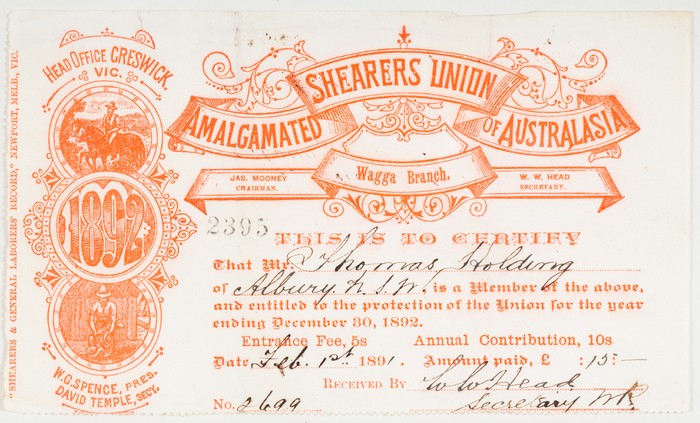Union Ticket
1891-92
Printed ephemera
Bequest of Sir William Dixson, 1952
DN / P 631
Through the 19th century, the conditions under which shearers worked were notoriously bad, with low wages often compounded by poor accommodation and rations. The Amalgamated Shearers’ Union was formed in 1887, and over the next few years won some improvements for members.
By the early 1890s relations between the shearers and pastoralists were becoming increasingly bitter. Drought, the introduction of mechanical shears and confrontations between unions, pastoralists and shearers culminated in strikes in Queensland and NSW, supported by maritime workers who refused to handle ‘black’ wool – wool harvested using non-union, or ‘scab, labour.
Thomas Holding may well have needed ‘the protection of the Union’ at this time. Depicting a figure mounted on horseback and a shearer at his stand in the shearing shed, his ticket is quite ornate. The text down the perforated left-hand edge, ‘Shearers & General Labourers’ Record’, refers to the newspaper of the shearers’ union. Like many union newspapers of today, the shearers’ paper included imagery, songs, poems and games designed to increase awareness, pride, loyalty and camaraderie among shearers and their labour struggle.
Battling for survival
The Amalgamated Shearers’ Union of Australasia was formed in 1887 by the amalgamation of the Australasian Shearers’ Union, the Bourke Shearers’ Union and the Wagga Shearers’ Union. It grew quickly to represent shearers across NSW, Victoria and South Australia, and by the early 1890s was fighting a battle of survival in strikes that spread across the colonies. Economic depression and severe drought savaged to wool industry and further impeded the effectiveness of the ASU. By 1894, the union, in order to maintain a strong union front in the rural sector, was forced to merge with other rural-based unions to form the Australian Workers’ Union. The AWU grew throughout the colonies to become one of the largest, most influential unions in Australia.
The Australasian Shearers’ Union was founded in Creswick, Victoria, by William Spence and David Temple. Spence was the son of a Scottish stonemason, and migrated to Australia with his family as a six-year-old. With no formal education, he worked as a farm labourer in rural Victoria from the age of 13. He later acquired a gold-mining licence and worked for various mining companies. In 1874 he was instrumental in the formation of the Amalgamated Miners’ Association of Victoria, and became its general secretary in 1882. Under his leadership the union merged with similar unions in the other Australian colonies to form the Amalgamated Miners’ Association of Australasia.
David Temple, the ASU’s co-founder, began his working life as a miner and part-time shearer in Victoria. Angered at the reduction of shearing rates in April 1886, Temple travelled from shearing shed to shearing shed organising shearers into a union. By the end of the season, the union had amassed 8000 members. In January 1887, the Temple’s union joined with the Wagga Wagga and Bourke shearers’ unions to form the Amalgamated Shearers’ Union of Australasia. Temple was elected general secretary and Spence president.



 Back to list
Back to list